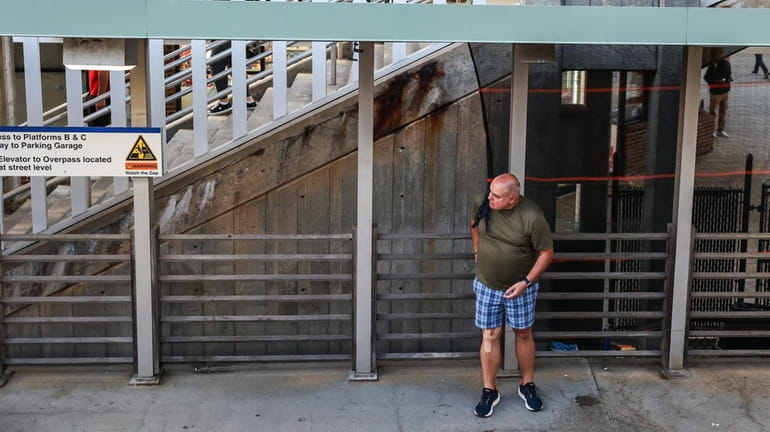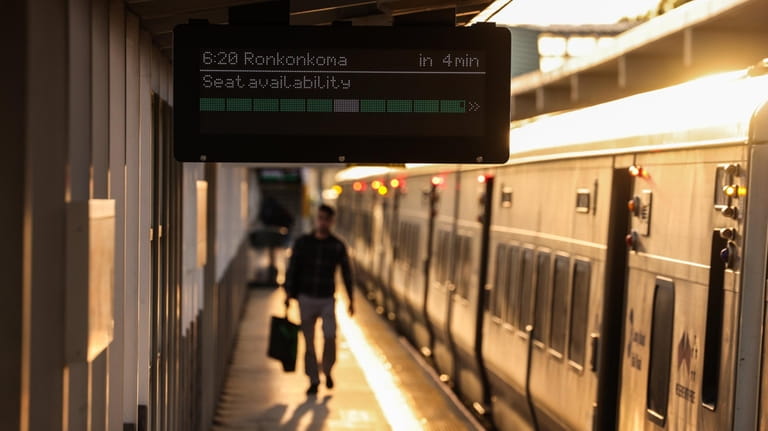LIRR delays more than doubled since Grand Central Madison opening

Long Island Rail Road delays have soared since the opening of Grand Central Madison, with the number of late trains more than doubling over the prior year, LIRR statistics show.
But railroad officials noted the boost in delays comes as the railroad runs significantly more trains than it did last year, and that the LIRR’s overall on-time percentage, while dipping, remains close to its goal of 94%.
In the first six months since the railroad altered its schedules in March, the railroad averaged 1,781 delays per month — peaking in August, when a Jamaica derailment contributed to the LIRR reporting 2,118 late trains, the most since July 2019, according to railroad statistics.
In comparison, over the prior 12 months ending in February of this year, the railroad averaged 776 monthly delays. That's an increase of 130%. There was only one month last year in which delays exceeded 1,000.
The average monthly delays between March and August were about 136% higher than for the same six-month period last year — 754 — and 21% higher than during the same period in 2019, before COVID-19. Between March and August of 2019, the LIRR averaged 1,472 late trains a month.
“I have noticed a change. Early in the year, the train was on time. But as the year started to get later, there have been a few late trains," said SUNY Old Westbury student Ethan Burke, 18, after stepping off a train in Ronkonkoma. "I’ve been late to class a couple of times, actually.”
Burke also was caught in the delays from the Aug. 3 derailment, which made him an hour late to his part-time job at a children’s play center.
“Luckily, my manager isn’t really too hard on me. He understood the whole situation, that I take the train,” Burke said.
The LIRR considers a train late if it arrives at its final destination more than five minutes and 59 seconds after its scheduled time.
Although the railroad’s incoming acting president, Robert Free, on Monday pointed to factors — including a rise in the number of riders taking trains to concerts and sporting events, and more customers traveling to and from the Hamptons over summer weekdays — the surge in late trains came at the same time as the railroad’s launch of full service to and from Grand Central Madison.
The addition of a second Manhattan terminal came with drastic changes to the railroad’s schedule, and a 40% boost in the number of trains the LIRR operates. Through the first eight months of this year, the railroad operated 48,000 more trains during the same period in 2022, a "staggering" figure, Free said.
So, although the number of late trains has risen dramatically, the drop in overall on-time performance has been less pronounced. Through August of this year, on-time performance fell to 93.9%, just below the railroad’s 94% goal. That's down from the record high rate of around 96% that the LIRR reported from 2020 through 2022, when it was carrying only a fraction of its usual customers, and also had curtailed service, because of the pandemic.
LIRR ridership since has rebounded to nearly 70% of pre-pandemic levels on weekdays, and close to 100% on weekends. On Wednesday, the LIRR carried 242,202 riders — the most of any weekday since the COVID-19 outbreak.
Although commuters working on Manhattan’s East Side have praised the addition of Grand Central Madison, others have complained about the schedule overhaul, as reflected in the LIRR’s most recent customer survey, which saw overall satisfaction plummet as compared to last year.
“I’m unsurprised that it’s taken us a little time to adjust and adapt and to figure out how to manage 900-plus trains a day, instead of 600-plus trains a day,” Janno Lieber, chairman and CEO of the Metropolitan Transportation Authority, said when asked about the LIRR’s growing delays Wednesday. “But that’s something that everybody is closely focused on, and we’ll continue to be.”
Peter Haynes, president of the LIRR Commuters Campaign, a rider advocacy group, is “not surprised at all” that the revamped schedules resulted in a drop in punctuality.
“The LIRR schedule was, basically, except for minor little tweaks, the same for decades. And, more or less, it worked,” Haynes said. He blamed the increasing delays on an aging train fleet that the railroad is now struggling to modernize, an ineffective system to identify root causes of delays, and an inaccurate method of measuring punctuality — only at a train's final destination, rather than at individual stops.
"All their sort of bad habits have come back to bite them, big time, right now," Haynes said.
Free said the LIRR is taking new measures to combat delays, including by using track-mounted cameras to more closely examine incidents commonly tied to delays, including track switch malfunctions and trucks striking LIRR bridge underpasses.
LIRR officials noted that on-time performance has been improving in recent days, even as ridership continues to climb. On Thursday, when the railroad carried 232,000 riders, it ran 100% of its morning peak trains on-time, according to LIRR statistics.
Syosset commuter Elliot Schechter said even with the added delays, the addition of Grand Central Madison is a “net positive.” He believes the LIRR’s original service plan for the launch of the new terminal was overly ambitious, in part because of the number of added local stops.
“The 8:03 at Grand Central never made it at 8:03. I think it was just completely unrealistic to expect a train with that many stops to make it in 55 minutes,” said Schechter, 59, who noted that the LIRR tweaked its schedules earlier this month to drop some local stops.
Now, he said, “They have a better chance of making it on schedule.”
Long Island Rail Road delays have soared since the opening of Grand Central Madison, with the number of late trains more than doubling over the prior year, LIRR statistics show.
But railroad officials noted the boost in delays comes as the railroad runs significantly more trains than it did last year, and that the LIRR’s overall on-time percentage, while dipping, remains close to its goal of 94%.
In the first six months since the railroad altered its schedules in March, the railroad averaged 1,781 delays per month — peaking in August, when a Jamaica derailment contributed to the LIRR reporting 2,118 late trains, the most since July 2019, according to railroad statistics.
In comparison, over the prior 12 months ending in February of this year, the railroad averaged 776 monthly delays. That's an increase of 130%. There was only one month last year in which delays exceeded 1,000.
WHAT TO KNOW
- Monthly LIRR train delays have skyrocketed since the opening of Grand Central Madison, averaging 1,781 late trains a month between March and August of this year, as compared with a monthly average of 776 in the prior 12 months — an increase of 130%.
- MTA officials point to a number of factors for the increased delays, including that the LIRR is running significantly more trains than before the addition of Grand Central Madison, as well as a rise in ridership. The LIRR’s overall on-time percentage remains close to its goal of 94%.
- Some critics blame the increase in delays on the LIRR adding too many stops to some trains, an aging fleet, and on ineffective methods of examining on-time performance.
The average monthly delays between March and August were about 136% higher than for the same six-month period last year — 754 — and 21% higher than during the same period in 2019, before COVID-19. Between March and August of 2019, the LIRR averaged 1,472 late trains a month.
“I have noticed a change. Early in the year, the train was on time. But as the year started to get later, there have been a few late trains," said SUNY Old Westbury student Ethan Burke, 18, after stepping off a train in Ronkonkoma. "I’ve been late to class a couple of times, actually.”
Burke also was caught in the delays from the Aug. 3 derailment, which made him an hour late to his part-time job at a children’s play center.
“Luckily, my manager isn’t really too hard on me. He understood the whole situation, that I take the train,” Burke said.
Grand Central Madison launch boosted trains
The LIRR considers a train late if it arrives at its final destination more than five minutes and 59 seconds after its scheduled time.
Although the railroad’s incoming acting president, Robert Free, on Monday pointed to factors — including a rise in the number of riders taking trains to concerts and sporting events, and more customers traveling to and from the Hamptons over summer weekdays — the surge in late trains came at the same time as the railroad’s launch of full service to and from Grand Central Madison.
The addition of a second Manhattan terminal came with drastic changes to the railroad’s schedule, and a 40% boost in the number of trains the LIRR operates. Through the first eight months of this year, the railroad operated 48,000 more trains during the same period in 2022, a "staggering" figure, Free said.
So, although the number of late trains has risen dramatically, the drop in overall on-time performance has been less pronounced. Through August of this year, on-time performance fell to 93.9%, just below the railroad’s 94% goal. That's down from the record high rate of around 96% that the LIRR reported from 2020 through 2022, when it was carrying only a fraction of its usual customers, and also had curtailed service, because of the pandemic.
LIRR ridership since has rebounded to nearly 70% of pre-pandemic levels on weekdays, and close to 100% on weekends. On Wednesday, the LIRR carried 242,202 riders — the most of any weekday since the COVID-19 outbreak.
MTA head: 'Something that everybody is closely focused on'
Although commuters working on Manhattan’s East Side have praised the addition of Grand Central Madison, others have complained about the schedule overhaul, as reflected in the LIRR’s most recent customer survey, which saw overall satisfaction plummet as compared to last year.
“I’m unsurprised that it’s taken us a little time to adjust and adapt and to figure out how to manage 900-plus trains a day, instead of 600-plus trains a day,” Janno Lieber, chairman and CEO of the Metropolitan Transportation Authority, said when asked about the LIRR’s growing delays Wednesday. “But that’s something that everybody is closely focused on, and we’ll continue to be.”
Peter Haynes, president of the LIRR Commuters Campaign, a rider advocacy group, is “not surprised at all” that the revamped schedules resulted in a drop in punctuality.
“The LIRR schedule was, basically, except for minor little tweaks, the same for decades. And, more or less, it worked,” Haynes said. He blamed the increasing delays on an aging train fleet that the railroad is now struggling to modernize, an ineffective system to identify root causes of delays, and an inaccurate method of measuring punctuality — only at a train's final destination, rather than at individual stops.
"All their sort of bad habits have come back to bite them, big time, right now," Haynes said.

Delays have more than doubled since Grand Central Madison opened. Credit: Newsday/Steve Pfost
Free said the LIRR is taking new measures to combat delays, including by using track-mounted cameras to more closely examine incidents commonly tied to delays, including track switch malfunctions and trucks striking LIRR bridge underpasses.
LIRR officials noted that on-time performance has been improving in recent days, even as ridership continues to climb. On Thursday, when the railroad carried 232,000 riders, it ran 100% of its morning peak trains on-time, according to LIRR statistics.
Syosset commuter Elliot Schechter said even with the added delays, the addition of Grand Central Madison is a “net positive.” He believes the LIRR’s original service plan for the launch of the new terminal was overly ambitious, in part because of the number of added local stops.
“The 8:03 at Grand Central never made it at 8:03. I think it was just completely unrealistic to expect a train with that many stops to make it in 55 minutes,” said Schechter, 59, who noted that the LIRR tweaked its schedules earlier this month to drop some local stops.
Now, he said, “They have a better chance of making it on schedule.”

